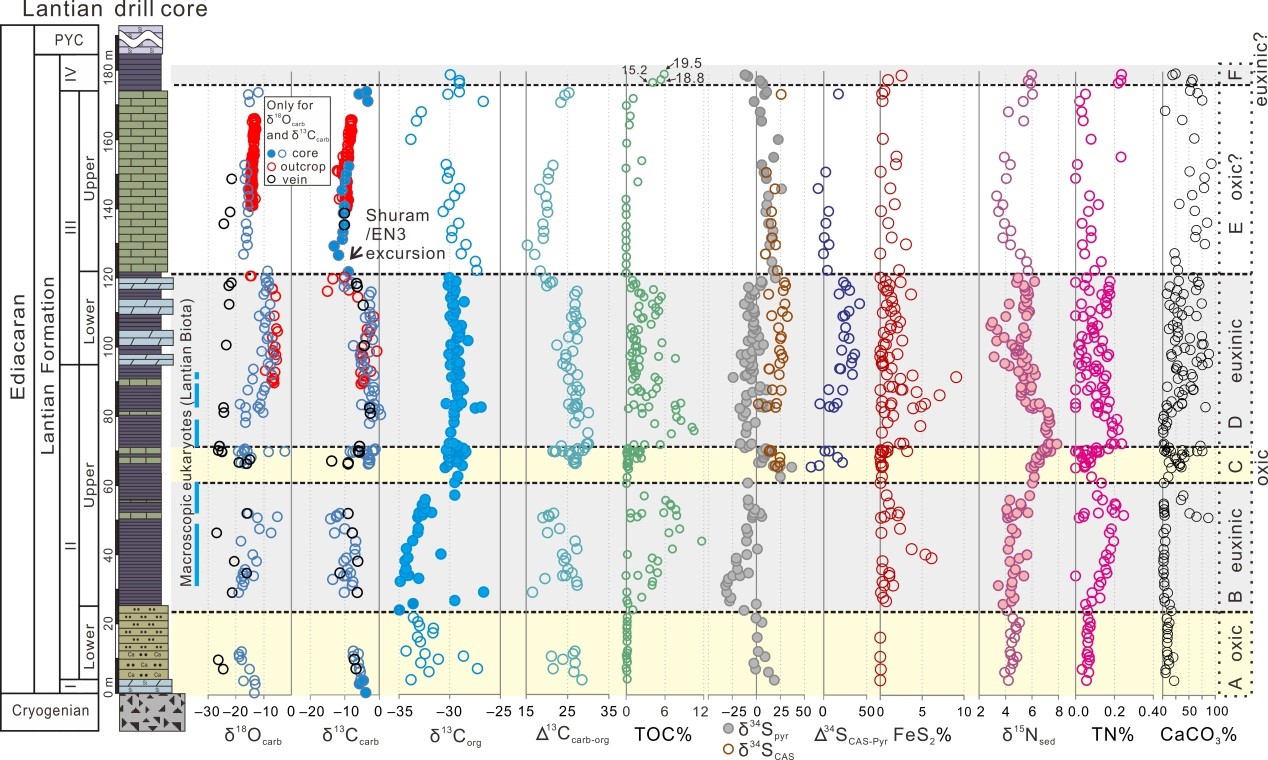
Chemostratigraphic profiles of the Lantian Formation
The coevolution of life and environment is highlighted in the recent debate on the possible relationship between ocean oxygenation and animal evolution in the Neoproterozoic. Some argue that the progressive oxygenation of the Earth’s surface in the late Neoproterozoic removed the final environmental hurdle to animal evolution, whereas others counter that atmospheric pO2 levels were sufficiently high to support basal animal metabolism in the Mesoproterozoic, long before the rise of animals themselves.
Building upon previous work, Dr. WANG Wei from Nanjing Institute of Geology and Palaeontology, Chinese Academy of Sciences and her colleagues recent attempts to test these competing hypotheses are focused on the compilations and meta-analyses of redox proxies. While these meta-analyses offer a critical view of the big-picture redox trend through the Neoproterozoic, they omit the more nuanced picture of spatial heterogeneity and often lack the stratigraphic resolution to appreciate the temporal dynamics of Neoproterozoic redox evolution. Ediacaran successions in South China, particularly the Doushantuo Formation, are highly fossiliferous. They are ideal targets for focused and integrated geochemical analysis at high resolution to infer the impact of redox conditions on evolution, ecology, and taphonomy. Previous studies of the Doushantuo Formation have been focused on shelf sections in the Yangtze Gorges and surrounding areas. To fully understand the Ediacaran redox structure of South China, it is necessary to gain insights from sections in deep-water slope and basinal facies.
High-resolution chemostratigraphic analysis of integrated geochemical data—including δ13Ccarb, δ13Corg, δ34Spyr, δ34SCAS, and δ15Nsed—from the Lantian Formation deposited in deep-water environments in South China allows a better resolution of the spatial patterns and temporal variations of Ediacaran oceanic redox conditions. A large spatial gradient of δ13Ccarb, with a magnitude of >10‰, is confirmed to be present in the lower Doushantuo/Lantian Formation. It is proposed that this gradient is largely due to the influence of 13C-depleted authigenic/diagenetic calcite cements in organic-rich and carbonate-poor sediments deposited in deep-water facies. A pronounced negative δ13Ccarb excursion in the upper Doushantuo/Lantian Formation, however, is spatially consistent and does not display a > 10‰ depth gradient. This negative excursion has been previously described as EN3 (Ediacaran Negative excursion 3) in South China and regarded as equivalent to the Shuram excursion in Oman.
The δ34Spyr record seems to show a spatial pattern, with more negative δ34Spyr values in deeper-water facies. The spatial pattern of δ34Spyr is interpreted as evidence for a chemically stratified basin, with predominantly euxinic deep waters where pyrite precipitated in the water column has lower δ34Spyr values.
The δ15Nsed record of the Lantian and Doushantuo formations is consistent. The δ15Nsed data suggest nitrate limitation and denitrification is often quantitative. The Lantian and Doushantuo formations do not preserve highly positive δ15Nsed values characteristic of partial denitrification in suboxic environments of modern oxygen-minimum zone. Integrated TOC, TN, δ34Spyr, and Fe speciation data suggest that oscillation between oxic and euxinic conditions is characteristic of the Lantian Formation.
Macrofossils in the Lantian Formation include morphologically complex macroalgae and putative animals. Stratigraphic distribution of these fossils is largely restricted to euxinic black shales.The euxinic environments were punctuated by brief oxygenation events when macroalgae and putative animals thrived, but were subsequently decimated and preserved when local environment switched to euxinic conditions.
Reference: Wang W, Guan C, Zhou C, Peng Y, Pratt L M, Chen X, Chen L, Chen Z, Yuan X, Xiao S. Integrated carbon, sulfur, and nitrogen isotope chemostratigraphy of the Ediacaran Lantian Formation in South China: Spatial gradient, ocean redox oscillation, and fossil distribution.Geobiology. 2017. doi: 10.1111/gbi.12226
